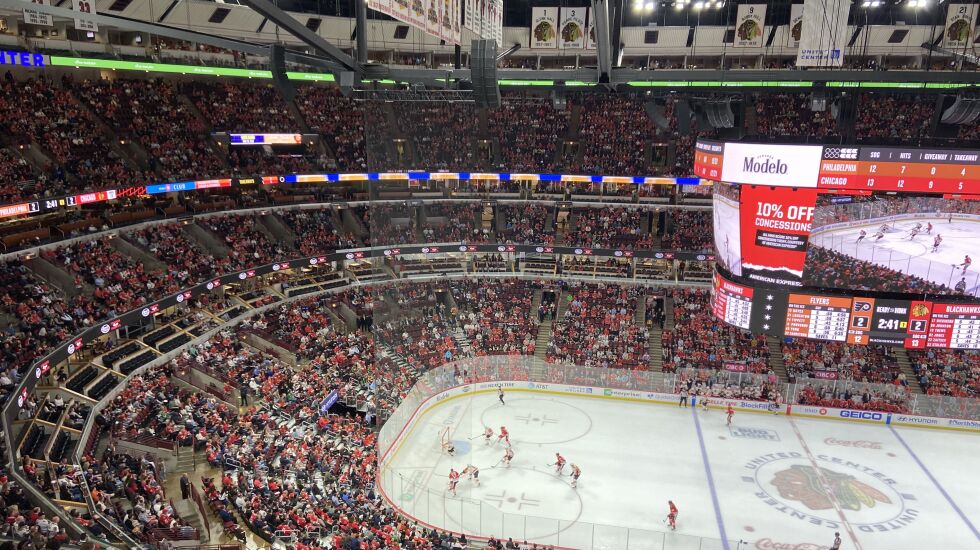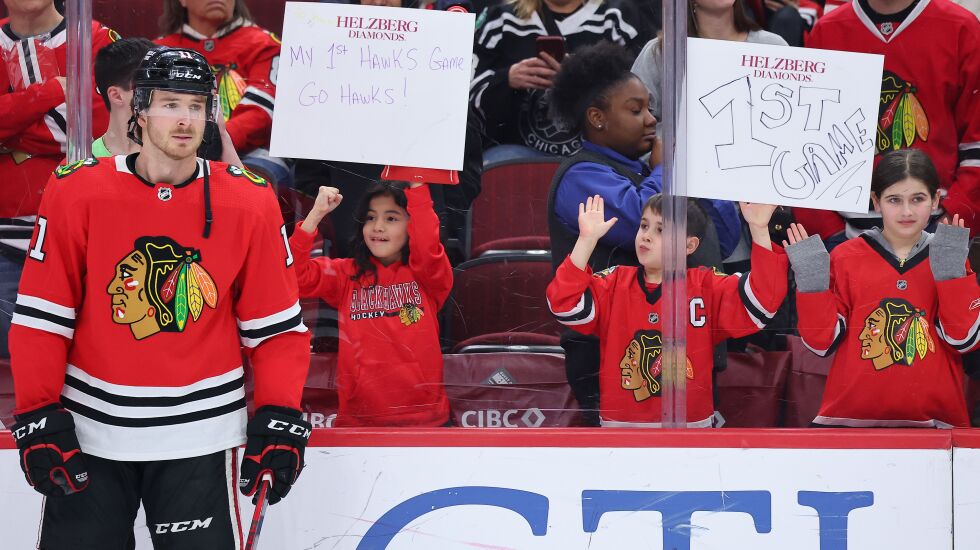
Which Blackhawks game will sell more tickets, one on a Tuesday against the Bruins or one on a Friday against the Coyotes?
It’s a difficult question. One features an attractive opponent on an unattractive night; the other features the opposite. Throw in other factors, such as themes (Black History Night for that Coyotes game), other events happening around Chicago and even the weather, and the question gets even trickier.
The Hawks don’t have to answer it themselves, however. They have a software model for that. It helps the front office know, for example, the aforementioned Bruins game will sell more.
The model constantly takes in data from countless sources on a minute-by-minute basis, applies that data to observed trends and makes projections for all 41 games on the Hawks’ home schedule — with supervision from Matt Gray, the team’s vice president of strategy and analytics.
It not only predicts ticket sales (the announced attendance) but also revenue, scan rate (the percentage of tickets used) and which areas of the arena will be higher or lower in demand. It then ranks every game — from first to 41st — in every category.
This technology is relatively new to the Hawks. For more than a decade, their on-ice success fueled a 531-game sellout streak that needed little effort or innovation from the sales and marketing departments.
But the pandemic and ensuing rebuild have changed things. The Hawks have invested far more in those departments since Jaime Faulkner came aboard as business president in December 2020. And the information that drives their decision-making processes comes largely from that model.
‘‘It’s almost like a ticker for the stock market,’’ Faulkner said. ‘‘It’s constantly taking in information — because things are coming on and off the secondary market or the primary market, or season-ticket holders are swapping in and out of tickets — and it’s learning what’s important and what’s not.’’
Entering the 2022-23 season, the model was spitting out fairly large, encouraging attendance projections. It predicted the Hawks would fill the arena regularly and flirt only a few times with the 14,000 number team executives had set as the lowest acceptable baseline.
Those executives, however, were skeptical. Entering the season, they used the model to divide the games into pricing tiers — setting ticket prices the highest for the most attractive games — but still thought it might be generally overly optimistic.
As it turned out, the model was correct — and, if anything, underestimated attendance. The Hawks ended up averaging 17,167 tickets sold, ranking 20th in the league despite their 30th-place finish in the standings.
‘‘There were a number of times I would say to Matt: ‘This says we’re going to sell 18,000 tickets. It’s a Tuesday night!’ ’’ Faulkner said. ‘‘But it has done a very good job of predicting.
‘‘On the outside, it makes no sense. We were one of the worst teams in the league, and our attendance has been what it has been. But then when you start to peel back the layers, [it makes more sense].’’
Crowds started relatively meager, with the Hawks averaging 14,591 tickets sold for their second through ninth home games. But the Marian Hossa jersey retirement Nov. 20 against the Penguins sold 21,182 tickets — well above the United Center’s official hockey capacity of 19,717 — and sales were strong from that point forward.
The Hawks averaged 17,888 tickets sold for the 22 home games from then through the end of February, never dipping below 15,000.
Figures were more volatile in March and April, after the roster had been gutted, but some scattered big crowds — including 20,188 for the aforementioned game against the Bruins and 20,219 for captain Jonathan Toews’ season-finale farewell — kept the average up.
| Month | Games | Average |
|---|---|---|
| 1. October | 5 | 14,868 |
| 2. November | 8 | 16,436 |
| 3. December | 6 | 16,609 |
| 4. January | 8 | 18,396 |
| 5. February | 4 | 19,090 |
| 6. March | 7 | 17,227 |
| 7. April | 3 | 18,088 |
The advance warning the model provided assisted with that. If it forecast lower-than-expected demand, the team could lower prices or pull other levers, such as new promotions, more advertising or even petitioning the NHL to change the game time.
‘‘If [a game] looks like it’s about to underperform, we’ll look at if we’re promoting the game properly and . . . in the right way,’’ Faulkner said. ‘‘Maybe the distribution is good, but the actual advertisement we’re using is the wrong hook. Maybe we should’ve been promoting, ‘It’s a weekend game, so come have a lot of fun,’ instead of promoting it some other way.’’
The Hawks tested whether advertising the theme of a game or the fact it fell on a weekend was more influential and found strong evidence for the latter. After price, the day of the week is the second-biggest factor that affects sales, with Saturday being the most attractive, followed by Friday, then Sunday.
Nonetheless, the Hawks hosted only three Saturday home games this season — for which they averaged 19,265 tickets sold.
That’s partially because the Bulls traditionally play home games on Saturdays and the Hawks on Sundays. But that’s also partially because the Hawks never before had told the NHL they wanted to maximize Saturday dates.
In fact, the United Center sat empty on eight of 26 Saturdays this season. The Hawks hope to claim as many of those available Saturdays as possible next season.
‘‘The prior Blackhawks never really informed the league of the things that were important, nor was there a partnership in trying to help things scheduled in a better way,’’ Faulkner said.

But why, exactly, was attendance so much higher than expected this season?
Faulkner attributed some of it to the Hawks’ on-ice product being less terrible than expected. The team finished 14-23-4 at home, but they were usually competitive. Removing empty-netters, only seven of those losses were by more than two goals.
A lot of it, however, was because of new fans — or at least fans who historically didn’t typically attend games in person — turning out in droves.
Generally lower prices and greater ticket availability helped, as did the Hawks’ expanded advertising and fan-outreach campaigns. But the magnitude of the Hawks’ brand recognition and appeal around the Chicago area, even this far removed from the dynasty era, became particularly evident.
As of the All-Star break (the most recent available data), single-game ticket sales were at an all-time high, representing 25% of total team revenue. And, remarkably, 76% of tickets scanned at United Center entrances had been held by people attending their first game of the season.
That trend gives the Hawks confidence that attendance will remain strong or potentially even increase next season, especially as their season-ticket membership base stabilizes after several years of unavoidable decline.
The season-ticket renewal rate for next season already has eclipsed 80% — up 23% from last season — and should keep ticking up through the summer.
How the Hawks fare in the draft lottery May 8 might increase demand significantly. Even in the worst-case scenario, however, it doesn’t seem as though fears about the United Center returning to mid-2000s levels of emptiness will end up being realized during the rebuild.
That’s a testament to the innovation of the front office and to the resilience of the fan base.







